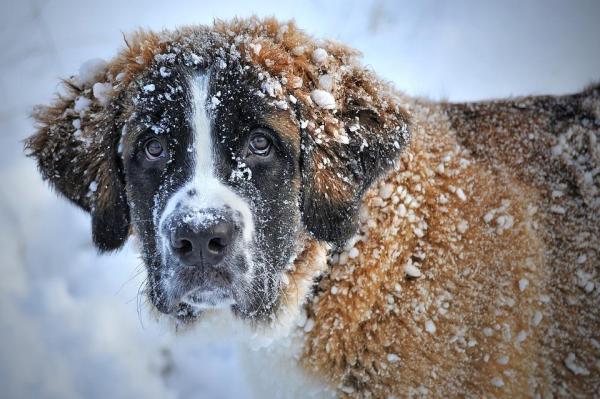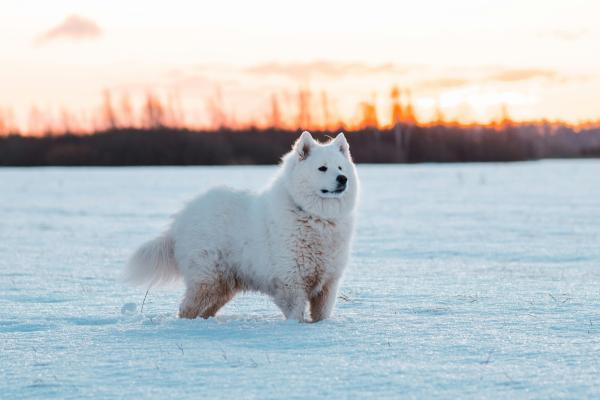Can Dogs Die From Cold Weather?



See files for Dogs
As a pet owner, you naturally worry about your dog's wellbeing in all conditions and seasons. When temperatures drop, this concern becomes even more pressing. The truth is that, yes, dogs can die from cold weather if proper precautions aren't taken. Cold exposure poses real risks to our pets, and can potentially lead to serious health complications and, in severe cases, death.
In this AnimalWised article, we'll explore how cold weather affects dogs, understand dangerous temperatures, recognize warning signs of hypothermia, and provide practical tips to keep your pet safe.
Can dogs really die from cold weather?
Yes, dogs can absolutely die from cold weather exposure. Despite their fur coats, dogs are vulnerable to dropping body temperatures when exposed to cold conditions for extended periods. When a dog's core temperature falls significantly below normal (which is typically 101-102.5°F or 38.3-39.2°C), they develop a dangerous condition called hypothermia.
Hypothermia occurs when the body loses heat faster than it can produce it, causing a dangerous drop in body temperature. In severe cases, this can lead to cardiac and respiratory failure, and ultimately death if not treated promptly.
Additionally, prolonged exposure to freezing temperatures can cause frostbite, particularly on extremities like ears, tail, and paws.
What makes some dogs more vulnerable to cold?
It is important to note that not all dogs handle cold weather equally. In fact, there are several factors affect a dog's cold tolerance:
- Coat type: dogs with thick double coats (like Huskies or Malamutes) have better natural insulation than short-haired or hairless breeds.
- Size: smaller dogs lose body heat more quickly than larger ones because they have a higher surface-area-to-volume ratio.
- Age: puppies and senior dogs have more difficulty regulating body temperature.
- Health status: dogs with certain medical conditions (especially hypothyroidism) are more susceptible to cold.
- Weight: very thin dogs have less insulation against the cold.
Interested in which dog breeds naturally handle cold weather better? Our other article shows you the dog breeds that thrive in winter conditions.

How cold is too cold for a dog to be outside?
There's no single temperature threshold that applies to all dogs, as cold tolerance varies significantly based on the factors mentioned before. However, there are general guidelines to consider:
- 45°F (7°C): potentially uncomfortable for dogs not acclimated to cold.
- 32°F (0°C): dangerous for small breeds, puppies, seniors, and short-haired dogs.
- 20°F (-7°C) and below: potentially life-threatening for most dogs if exposed for extended periods.
Even cold-adapted breeds like Siberian Huskies, while able to withstand temperatures below freezing when active, shouldn't be left outside in extreme cold for prolonged periods without adequate shelter and monitoring.
The sensible approach is to observe your dog's behavior and physical responses to the cold. Environmental factors like wind chill, precipitation, and humidity can make temperatures feel much colder than the thermometer indicates.
Can a dog survive in the cold overnight?
While it varies depending on the dog's breed, size, coat, and the exact temperature, the risk is high. For most domestic dogs, cold weather can quickly become life-threatening. Leaving a dog outside overnight in freezing temperatures without truly adequate, insulated shelter is extremely dangerous, and sadly, dogs can die from cold.
To truly keep your pet safe, especially during a cold night, always bring them indoors. Dogs rely on their owners to protect them from environmental dangers they cannot escape themselves.

Symptoms of hypothermia and cold danger
Knowing how to spot when your dog is dangerously cold could save their lives. Dogs can't tell us when they're suffering, so it's vital to monitor them closely in cold weather.
Your quick action depends on recognizing these critical signs of hypothermia and cold stress:
- Shivering: is the most obvious sign, though it may actually stop in advanced hypothermia.
- Muscle stiffness: your dog may move awkwardly or seem reluctant to walk.
- Lethargy: unusual tiredness, weakness, or lack of energy.
- Breathing changes: look for slow, shallow breathing that may be difficult to notice.
- Cold extremities: ears, paws, and tail that feel cold to the touch.
- Heat-seeking behavior: unusual attempts to find warm places or tightly curling up.
- Unusual vocalization: such as whining or making sounds they don't typically make.
- Coordination problems: stumbling, clumsiness, or disorientation.
- Eye changes: fixed gaze or dilated pupils in more serious cases.
- Collapse: in severe cases, your dog may be unable to stand or respond normally.
When you notice these signs, don't wait. Take immediate action to keep your pet safe:
- Bring your dog into a warm environment right away.
- Wrap them in warm, dry blankets to begin gradually raising their body temperature.
- Apply indirect warmth using warm (never hot) water bottles wrapped in towels against their core body area.
- Call your veterinarian immediately. Even if symptoms seem to improve, internal damage may have occurred that requires professional care
Concerned about how cold affects your dog's internal systems? Discover more about the medical details, warning signs, and veterinary treatments for dangerously low body temperatures in our other article on hypothermia in dogs.

How to keep your pet safe in the cold
When it comes to cold weather and your dog, prevention is always your best strategy.
Outdoor time:
Start by limiting your dog's outdoor time during particularly cold days, especially for puppies, seniors, small breeds, and those with short coats. When the temperature drops below freezing, brief bathroom breaks may be all some dogs can safely handle.
After winter walks, take a moment to thoroughly wipe your dog's paws, legs, and belly. This simple step removes ice particles, salt, and de-icing chemicals that could cause irritation or be ingested when your dog grooms themselves. Pay special attention to the spaces between toe pads, where ice balls often form.
Be strategic about scheduling walks during the warmest parts of the day, typically midday hours when the sun has had time to raise temperatures slightly. This simple timing adjustment can make outdoor exercise significantly more comfortable and safer for your dog.
Proper shelter:
If your dog absolutely needs to spend time outdoors when it's cold, providing them with a proper shelter isn't just an option – it's essential for their safety. A good cold-weather shelter needs specific features to be truly effective:
- It should be raised off the cold ground to prevent chilling.
- It must have thick insulation and dry bedding inside to retain warmth.
- It needs to completely block the wind.
- It should be just the right size.
Getting the size right is crucial. The shelter needs to be large enough for your dog to comfortably lie down, but small enough that their body heat can warm the space and stay trapped inside. Remember, a doghouse that's too big can actually feel colder, because your pet's warmth gets lost in the excess space instead of building up.
Protective clothing:
To truly keep your pet safe when you head out in the cold weather, sometimes they need extra layers, just like we do. Protective clothing isn't just a cute look for many dogs, it's actually a safety necessity.
- Make sure the clothes fit well, covering them from neck to tail without getting in the way when they need to go to the bathroom.
- Don't forget their paws, either. Walking on icy sidewalks, snow, or streets treated with salt can be really painful and harmful. Dog booties or a protective paw wax are essential to prevent painful ice buildup between toes, stop their pads from cracking, and shield them from irritating salt and chemicals.
Explore our other article to determine whether your specific pet needs additional cold-weather protection.
Diet:
Adjust your dog's diet during extended cold periods, especially for active outdoor dogs. Cold weather increases calorie requirements as their bodies work harder to maintain temperature, sometimes up to 30% more food is needed. Consult your veterinarian about appropriate winter feeding adjustments for your specific pet.
Finally, make sure to maintain access to unfrozen water requires extra vigilance during cold spells. Check water bowls frequently, consider heated water dishes for outdoor dogs, and remember that proper hydration actually helps maintain body temperature.

If you want to read similar articles to Can Dogs Die From Cold Weather?, we recommend you visit our Basic care category.
- American Veterinary Medical Association. (2024). Cold weather animal safety. AVMA.org.
- Perry, S. G., & Wright, K. N. (2022). Emergency treatment of hypothermia and frostbite in dogs. Veterinary Partner.
- Renner, M. S., & Miller, R. E. (2022). Frostbite in captive exotic animals. Journal of Zoo and Wildlife Medicine, 53(2), 425-442. https://doi.org/10.1638/2021-0109
- Tufts Animal Care and Condition Program. (2023). TACC Weather Safety Scale. Tufts University.









